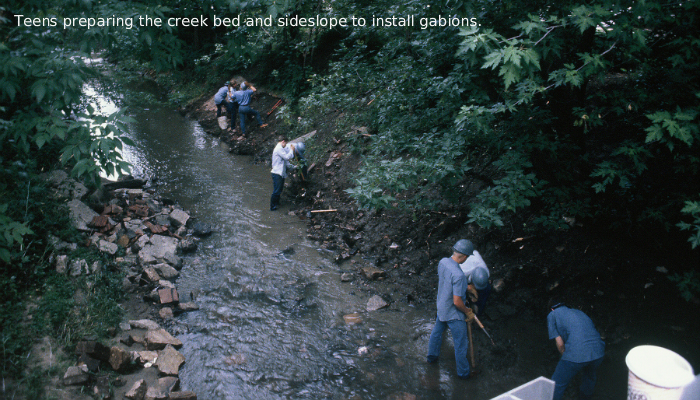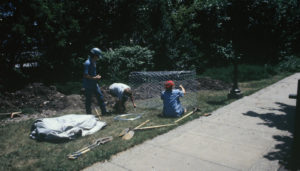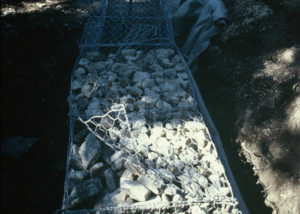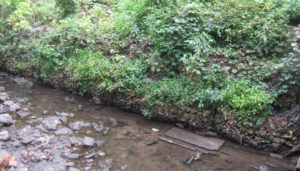Managing Ralston Creek with Gabions

For more than a century, Iowa City has encroached on Ralston Creek. The runoff from the outlying suburbs is managed by large dams on Scott Boulevard and in Hickory Hill Park. But downtown is mostly impermeable surfaces, making runoff very flashy. And with fill dirt pushed in closer and closer to the water, the floodplain is now just a narrow channel, leading to higher velocities and more bank erosion.
During the Great Depression, a project was undertaken to line part of the downtown channel. Thick and heavy tiles were laid up brickwork pattern on the bottom and sides, and all locked together with steel rebar run through the precast holes. In its day, it was probably very effective in controlling erosion. But by the 1980s, the steel had rusted through in numerous places, the tiles were cracked and crumbling, and erosion was getting underway again.

Wiring up the gabion baskets.
In the 1990s the Mayor’s Youth Corps was looking for a project, and I suggested we select a place where bank erosion was getting underway again and replace the old failing tile-and-rebar structure with gabions built by the teens – with supervision.
Gabions are rectangular steel mesh baskets, which are staked in place to prevent moving, wired to their neighbors to form linear or 3D structures, filled with rock, and lids wired on. They are often stacked and wired several tiers high, with setbacks, along eroding creek banks.
The site chosen was the west bank where the creek emerges from beneath the intersection of Washington and Van Buren Streets. The Corps purchased the gabions, which are shipped disassembled as flat panels, and wired them up into open baskets. Then the teens squared off the creek edge with shovels to form a flat spot for the baskets, saving the broken tiles for fill, and bundling up the frail rebar for recycling. They had their own supervisors and didn’t seem to need me, so I didn’t return for about 5 days.

Bottom row of gabions installed, lids going on.
This was a mistake. When I returned, about eight baskets had already been installed, but the internal cross-wires, which keep the sides from bulging out, had been forgotten. The teens had already hauled tons and tons of rock, in buckets, down the steep slope to fill the baskets, plus scavenging a lot of broken tiles plus miscellaneous concrete and bricks of unknown origin, which littered the waterway. And here I was – telling them that they had to take it all apart and start over!!! There was mutiny in the ranks for a while, so I walked over to my office and pulled some slides I had taken for my Engineering Geology class, which showed some serious gabion structures, plus a battery operated screen viewer (yesteryear’s laptop), and we reviewed the basics.

Same view as first photo, now 2017, gabions overgrown with grapevines.
So after several grumpy days of dismantling, we were back on track, putting together a project that was going to last a lot longer. Since then, I have observed it every year, and it has remained “rock solid.” Wild grapevines have covered the gabions and are occasionally pruned back by high water. This year, the bottom tier of the two-tier bank stabilization wall has remained quite visible.
Those teens are now in middle age and I hope they look back on this project with some pride, because it has proven very durable and functional.


